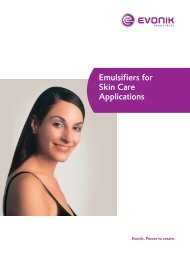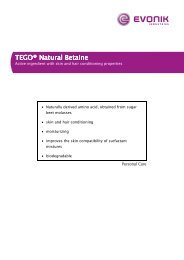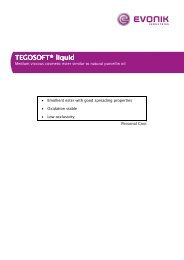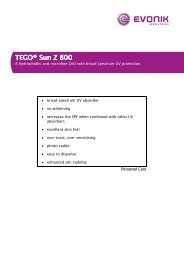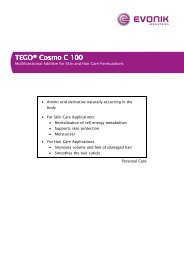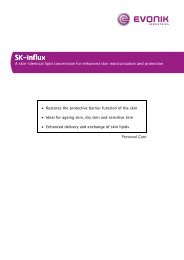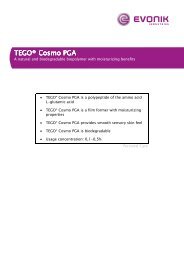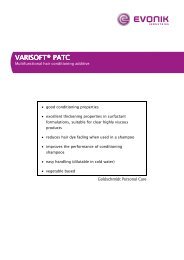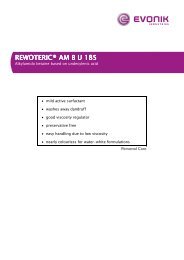ISOLAN® GPS ISOLAN® GPS
ISOLAN® GPS ISOLAN® GPS
ISOLAN® GPS ISOLAN® GPS
You also want an ePaper? Increase the reach of your titles
YUMPU automatically turns print PDFs into web optimized ePapers that Google loves.
Preparation<br />
A pre-requisite for this is careful adjustment of the<br />
formulation (phase ratio, viscosity of the oil phase)<br />
and optimum emulsification.<br />
The particle size for creams which are stable over a<br />
long period of time is below 1 m, for lotions<br />
approx. 2 - 4 m. More coarsely dispersed<br />
emulsions tend to separate.<br />
Thorough, but not too intensive homogenization is<br />
required. Extreme energy input frequently causes the<br />
formation of highly viscous, metastable secondary<br />
structures which break down on storage. Under such<br />
conditions lotions may transiently reach cream-like<br />
consistency, e. g. by several passages through a<br />
colloid mill.<br />
Optimum manufacturing conditions correspond to<br />
the principles of normal production processes for<br />
W/O emulsions.<br />
The water phase is incorporated slowly into the oil<br />
phase which contains the emulsifier while stirring<br />
intensively. The coarsely dispersed pre-emulsion is<br />
then homogenized. The final homogenization should<br />
be performed below 30°C.<br />
The temperature program is variable and can take<br />
the form of:<br />
• hot/hot procedure (H/H)<br />
• hot/cold procedure (H/C)<br />
• cold/cold procedure (C/C)<br />
In addition to the traditional hot/hot procedure (both<br />
phases 80 - 90°C) the hot/cold procedure can be<br />
used. It is characterised by incorporation of the cold<br />
water phase (15 - 30°C) into the hot oil phase which<br />
significantly shortens the time of manufacture.<br />
Homogenization should be carried out below 30°C in<br />
order to ensure that the waxes have recrystallized.<br />
Emulsifying machines<br />
Stirring equipment or planetary mixers with high<br />
sheering force are suitable for the manufacture of<br />
creams and lotions in the laboratory and production<br />
scale, provided that they can insure uniform workup<br />
of the emulsion. Machines predominately used in<br />
the cosmetic industry, which are equipped with<br />
stirrer, stripper and rotor-stator homogenizer, fulfill<br />
all requirements for optimum emulsification.<br />
However, utilization of their maximum capacity may<br />
result in over-emulsification. High-pressure<br />
emulsifiers may cause problems because of the<br />
danger of over-emulsification and liberation of water<br />
due to cavitation.<br />
Recommended usage concentration<br />
2.0 - 3.0% ISOLAN ® <strong>GPS</strong><br />
Packaging<br />
400 kg (16 x 25 kg drum)<br />
Hazardous goods classification<br />
Information concerning<br />
• classification and labeling according to<br />
regulations for transport and for dangerous<br />
substances<br />
• protective measures for storage and handling<br />
• measures in case of accidents and fires<br />
• toxicity and ecological effects<br />
is given in our material safety data sheets.<br />
It is possible to process W/O Lotions based on<br />
ISOLAN ® <strong>GPS</strong> cold/cold. In cold processed<br />
formulations a viscosity enhancing and stabilizing<br />
system in the oil phase is necessary. 0.5 % Zinc<br />
Stearate proved to be most effective.<br />
The decisive criterion for production is the viscosity.<br />
Mechanical processing is dis-continued when the<br />
viscosity is equal to that of the standard emulsion<br />
developed and tested in the laboratory.



